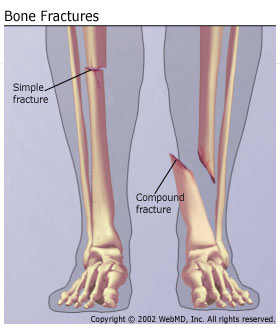Fractures
 There are 206 bones in the human body. The skeleton holds our skin up and bones act as factories for producing blood and essential blood cells through bone marrow. Bones are also integral to the body's strength.
There are 206 bones in the human body. The skeleton holds our skin up and bones act as factories for producing blood and essential blood cells through bone marrow. Bones are also integral to the body's strength.
Some bones have a protective function (skull), some a supporting function (pelvis), while others are for movement (fingers).
When a bone is broken or fractured, it affects not only blood production and function, but there can be complications associated with the muscles, tendons, nerves and blood vessels that are attached or are close, to the bone.
Fractures are generally classified as:
- Open. Where there is a wound exposing the fracture site or the bone is protruding from the skin.
- Closed. Where the bone has fractured but has no obvious external wound.
- Complicated. Which may involve damage to associated vital organs and major blood vessels as a result of the fracture
Immobilisation is the preferred way to manage fractured limbs as it helps reduce movement and the pain associated with fractures. Immobilise the limb with a natural splint, such as another part of the body, improvised splints, cardboard, wooden or air splints.
Fractures may be caused a number of ways:
- Direct force. Where sufficient force is applied to cause the bone to fracture at the point of impact.
- Indirect force. Where force or kinetic energy is applied to a large, strong bone and is transmitted up the limb, causing the weakest bones to fracture.
- Spontaneous or spasm-induced. Where fractures are associated with disease and/or muscular spasms. These are usually associated with the elderly and people with specific diseases affecting the bones.
Always exercise care when assessing an elderly casualty as the condition known as osteoporosis or 'chalky bones' causes bones to fracture easily, often in several places. Always suspect a fracture if an elderly person complains of pain or loss of power to a limb.
Be especially aware of fractures at the neck of the femur (near the hip), a very common fracture in the elderly.
Young children are also prone to fractures. Arm and wrist fractures are common with children.
As young bones do not harden for some years, children's fractures tend to 'bend and splinter', similar to a broken branch on a tree - hence the common name 'greenstick fracture.
Sign and symptoms
Some or all of the following
- Pale, cool, clammy skin
- Rapid, weak pulse
- Pain at the site
- Tenderness
- Loss of power to limb
- Associated wound and blood loss
- Associated organ damage
- Nausea
- Deformity
Care and treatment
Care and treatment of fractures relies on immobilising and adequately splinting the injury. If the fracture is particularly complex, the wound associated with an open fracture maybe difficult to control.
If the pulse further down the limb cannot be restored by gentle and careful adjustment of the limb or with minor traction, the limb should be stabilised where it is.
Do not spend time attempting to splint instead of calling for urgent ambulance transport.
Circulation must be checked after a splint or sling has been applied. If the limb swells this will make the bandages tighter and this may cause circulation problems.
Indications a bandage may be too tight include:
- Absent pulse below the bandage
- Pale/blue appearance below the bandage
- Lack of warmth below the bandage
- Pain
- Swelling
- Tingling or loss of feeling in fingers or toes
Generally, fractured limbs should be kept immobile until medical assistance arrives. However, in remote areas or where it is some time from medical aid, you may be required to treat as follows:
Fractured arm/collar bone
- Check for warmth or pulse to the hand If no circulation gently and carefully adjust the position of the limb until pulse returns
- Treat any wounds
- Pad bony prominences
- Apply adequate splint
- Secure splint above and below fracture
- Reassess pulse or return of colour/warmth after splint applied
- Apply appropriate sling
- Fractured lower arm - apply arm sling
- Fractured upper arm - apply collar and cuff sling
- Fractured collar bone - apply elevated sling
- Reassess pulse or return of colour/warmth after sling applied
- Adjust bandages or sling if required
Fractured leg
- Check for warmth or pulse to the foot, if no circulation - if possible, gently and carefully adjust the position of the limb until pulse returns.
- Treat any wounds
- Immobilise the limb
- Pad bony prominences
- Reassess circulation below injury
- Adjust bandages if required
Fractured pelvis
- Call Triple Zero (000) for an ambulance
- Check for pulses in both legs
- Bend legs at knees, elevate lower legs slightly and support on pillows or similar
- Support both hips with folded blankets either side
- Discourage attempts to urinate
- Adjust bandages if required
Care must be exercised with a suspected fractured pelvis. This injury may have serious complications. The casualty should always be transported by ambulance and not by alternative means unless absolutely essential.
Fractured jaw
A common injury in certain contact sports is dislocation or fracture, of the lower jaw (mandible). The casualty will have pain in the jaw, be unable to speak properly, and may have trouble swallowing.
- Call Triple Zero (000) for an ambulance
- Support the jaw - sit the casualty leaning slightly forward - rest the injured jaw on a pad held by the casualty
Do not apply a bandage to support the jaw.
Observe the casualty carefully for signs of breathing difficulties and any indication they are becoming drowsy or unconscious.